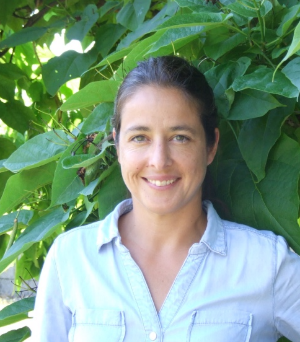Written by Bernardita Sallato, August 2021
During the 2019 apple harvest in the Yakima Valley of Washington State an apparently new disorder was detected in fruit of several cultivars. The disorder first appeared in ‘Honeycrisp’ apples during routine quality control checks. Slices through fruit revealed discolored, corky spots of tissue that appeared to be associated with the vascular bundles throughout the flesh. Interestingly, dissection was necessary – there were no external symptoms. In my analyses since this first discovery, the incidence of this disorder has varied from about 45% to 70%. It is particularly troubling that these levels of incidence were all found in fruit that was already sorted and packed. The incidence of this disorder across the WA apple industry is difficult to assess due to the lack of external symptoms, but fruit lots have already been rejected from its discovery. In the following I describe symptoms of this disorder and my preliminary assessments of incidence and severity.
Throughout the 2019 and 2020 apple harvests I received fruit from several packing facilities in order to better assess incidence and understand symptoms and severity. Assessments were made of ‘Honeycrisp’, ‘Jazz’ and ‘Juici’ apple fruit. In each case, fruit were individually weighed and assessed for any external symptoms (e.g black spots, bruising, russet, color, lenticel damage, insect damage, among others). Following external evaluations, each fruit was peeled to assess sub-epidermal symptoms in the flesh, and then cut deeper towards the fruit core to assess internal symptoms. For superficial and internal symptoms in the flesh, severity was recorded as the number of necrotic areas and classified as healthy (no necrotic spots), light (between 1 and 10 spots), medium (between 11 and 20 spots) and severe (over 21 spots), irrespective of the spot diameter.

Symptom description
The symptoms of this disorder were similar across all cultivars, and commonly appeared as dessicated, brown discolored cells surrounding the vascular tissue (Figures 1-4). The flesh surrounding the dead and necrotic vascular tissue becomes corky, and brown (Figure 3-4). The shape of the lesion follows the vascular tissue, randomly throughout the fruit. In fruit with only mild incidence, the corky spots were found closer to the core of the fruit. In severely affected fruit, however, the necrosis of vascular tissue exhibited no specific pattern and could be found throughout the tissue, from the hypodermal layer to the core. Symptom incidence and severity did not correlate with skin color, size, weight, or to the fruit exposure to the sun.
It appears that these symptoms develop on the tree, prior to harvest, however, it is not known whether the condition worsens during storage.
In ca. 60 percent of fruit with the disorder, there were no external symptoms, and the fruit appears to be healthy (Figure 1 to 3). In 11% of the fruit with the disorder, the internal necrosis correlated with darker round lesions in the skin, ranging between one mm to 5 mm in diameter (Figure 4 and 5). External symptoms in the fruit skin develops only when the flesh underneath it has vascular necrosis and in severe cases. In severely affected fruit, the darker lesion in the skin can be larger ( > 2 mm) and sunken (Figure 5).



Since 2019, my team and I have continued to investigate this new disorder, including undertaking a complete nutrient assessment in several orchards with fruit exhibiting symptoms. At this stage, the causes of this disorder are not clear. As the 2021 crop is being harvested, I encourage growers and packers examine fruit prior to harvest or storage to assess the presence of this disorder. If you encounter symptomatic fruit, please contact me.
Aknowledgment: Garret Bishop, GS Long for helping with ongoing research.
Contact
WSU Tree Fruit Extension Specialist
24105 North Bunn, Rd. Prosser, WA
email: b.sallato@wsu.edu
Mobile: (509) 439-8542

